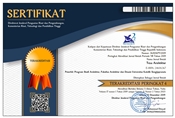RUMAH PRODUKTIF (SEJAHTERA) BAGI MASYARAKAT TANPA PEKERJAAN (The Productive House for Jobless People)
Abstract
Keywords
Full Text:
PDFReferences
Ardy Padma, et.al., 2001, Kampung Naga, Permukiman Warisan Karuhun. Bandung, Architecture & Communication.
Hasbullah, J. 2006., Sosial Kapital: Menuju Keunggulan Budaya Manusia Indonesia.Jakarta: MR-United Press.
Fani Deviana & Titi Utami, Manuskrip, 2012Evaluasi pembentukan kelembagaan masyarakat pada implementasi program penataan kawasan permukiman di hulu DAS melalui penilaian dimensi modal sosial.
Fukuyama, Francis. 1995. Trust : The Social Virtues and The Creation of Prosperity. New York: Free Press Paper Backs.
Machmoed Zain, 2010,Reformasi Pengentasan Kemiskinan: Dari Pendekatan Ekonomi Ke Pendekatan Kesejahteraan, Jurnal Masyarakat Kebudayaan Dan Politik, FISIPUniversitas Air Langga. Volume 12, Nomor 4, hal 79 - 96.
Pranadji, Tri, 2006. Penguatan Modal Sosial Untuk Pemberdayaan Masyarakat Perdesaan dalam Pengelolaan Agroekosistem Lahan Kering. Jurnal Agro Ekonomi, Vol 24 No. 2, Oktober 2006, hal. 178 206.
Pranadji, Tri, 2009, Penguatan Kelembagaan Gotong Royong Dalam Perspektif Sosio Budaya Bangsa, Jurnal Forum Penelitian Agro Ekonomi, Vol. 27 No. 1, hal. 61-72.
Agus Supriono, Dance J. Flassy, Sasli Rais, 2005., Modal Sosial1: Unsur- Unsur Pembentuk.
Kementerian Ristek, Mangga, Teknologi Tepat Guna, http://www.iptek.net.id/ind/warintek/? mnu=6&ttg=2&doc=2a13, diunduh pada 2 Januari 2013.
Sajogyo & Pujiwati, S., 2011, Sosiologi Perdesaan, Gadjah Mada University Press.
Sri Wahyuni, MP , 2013, Panduan Praktis Biogas, Penebar Swadaya, Jakarta.
Tuti kustiasih, Lya Meilany,dkk , 2013, Laporan Penelitian Penentuan Faktor Emisi Gas Rumah Kaca dari Sampah Organik Yang Dapat Terdekomposisi,Puslitbang Permukiman Kementerian PU,
Jounathan Rouse, Silke Rothenberger, Chris Zurbiigg, Eawag, 2008, Marketing Cmpost , A Guide For Compost Producers in Low andMiddle Income Countries.
Kementerian Pekerjaan Umum, 2008, Modul Penampungan Air Hujan, Lampiran Permen PU Tentang Penyelenggaraan Pengembangan SPAM Bukan Jaringan Perpipaan.
DOI: https://doi.org/10.24167/tesa.v13i1.355
ISSN 1410-6094 (Print) | ISSN 2460-6367 (Media Online) | View My Stats

This work is licensed under a Creative Commons Attribution 4.0 International License.








